Aetiology
Pruritus can be either acute or chronic, with the chronic form lasting for 6 weeks or longer.[1]
Chronic pruritus can be classified according to skin changes or based on aetiology.
Clinical classification of chronic pruritus according to skin changes may be characterised as itching on primarily diseased, inflamed skin; pruritus on primarily normal, non-inflamed skin; and itchy skin with chronic secondary scratch lesions.[1]
Classification of chronic pruritus based on aetiology depends on the underlying disease. According to the current pruritus classification, itching that accompanies systemic diseases is defined as systemic pruritus, although sometimes this type can be classified as neurogenic (e.g., cholestatic pruritus) or neuropathic (e.g., pruritus in diabetes mellitus patients due to polyneuropathy).[1]
Based on the site of the generation of pruritic stimuli, the following pruritus subtypes are defined:[1][25][26]
Dermatological itch (formerly pruritoceptive itch): connected with activation of epidermal and dermal pruritoceptors by different mediators due to inflammation, skin dryness, or other skin damage. This type of pruritus is typical for conditions such as urticaria, skin xerosis, scabies, insect bite reaction, or parasitic infections.[Figure caption and citation for the preceding image starts]: Acute urticaria: typical whealsFrom the collection of Adam Reich MD, PhD [Citation ends].
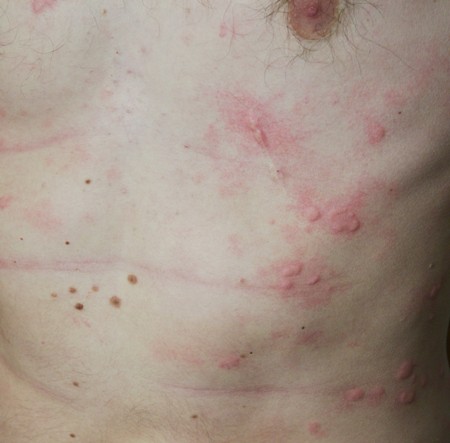 [Figure caption and citation for the preceding image starts]: Urticaria: whealsFrom the collection of Adam Reich MD, PhD [Citation ends].
[Figure caption and citation for the preceding image starts]: Urticaria: whealsFrom the collection of Adam Reich MD, PhD [Citation ends].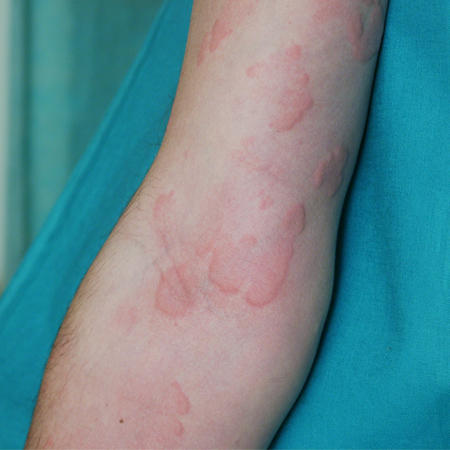 [Figure caption and citation for the preceding image starts]: ScabiesFrom the collection of Adam Reich MD, PhD [Citation ends].
[Figure caption and citation for the preceding image starts]: ScabiesFrom the collection of Adam Reich MD, PhD [Citation ends].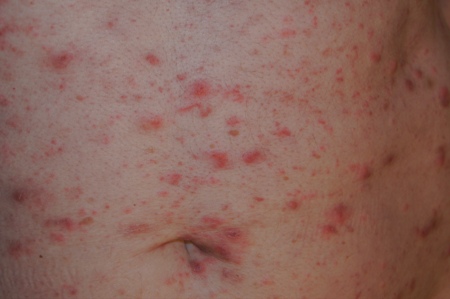 [Figure caption and citation for the preceding image starts]: Scabies: typical lesions within interphalangeal areasFrom the collection of Adam Reich MD, PhD [Citation ends].
[Figure caption and citation for the preceding image starts]: Scabies: typical lesions within interphalangeal areasFrom the collection of Adam Reich MD, PhD [Citation ends].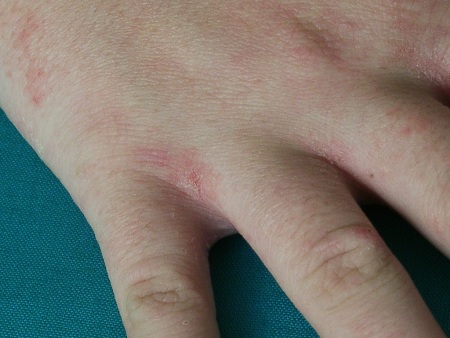
Systemic itch: arising from 'disease' of organs other than the skin, such as the liver (e.g., primary biliary cirrhosis), kidney (e.g., chronic renal failure), blood (e.g., Hodgkin's disease, T-cell lymphoma), and certain multifactorial (e.g., metabolic) states or drugs.[15][27]
Neurological itch: originates in the nervous system due to activation of some components of the itch pathway. Neurological itch can be induced centrally but without evidence of neural pathology (i.e., neurogenic itch due, for example, to receiving opioid receptor agonists), or it can be caused by damage of some components of the itch pathway (i.e., neuropathic itch such as postherpetic itch; notalgia paraesthetica; localised pruritus due to compression of posterior rami of spinal nerve roots Th2 to Th6; brachioradial pruritus: localised pruritus due to compression of spinal nerve roots C5 to C8; or itch associated with multiple sclerosis, brain tumours, or brain injuries).[28][29][30] Pruritus affects about 5% of patients with multiple sclerosis.[28] It is frequently a paroxysmal, symmetrical, segmental itching lasting for several seconds to minutes.
Psychogenic/psychosomatic itch: associated with psychosomatic or psychiatric disorders such as schizophrenia or depression.[28]
Mixed aetiology itch: refers to the situation in which more than one cause is present. For example, itching is a very common symptom in HIV-infected patients and can have multiple aetiologies: HIV-associated eosinophilic folliculitis, pruritic papular eruption, xerosis, seborrhoeic dermatitis, psoriasis, scabies, superficial fungal infections, drug eruptions, urticaria, or photosensitivity reactions; aetiology may be idiopathic. Post-burn pruritus is a complication of burns that can be most distressing to patients, and may interfere with sleep and activities of daily living.[31][32] The aetiology of post-burn pruritus is not clear but is most probably related to the damage of dermal nerve endings (neurological itch). However, as post-burn pruritus usually appears during a healing process of burns, a significant influence of some pruritogenic mediators (e.g., cytokines or enzymes) cannot be excluded (dermatological itch). It is therefore of mixed aetiology.[Figure caption and citation for the preceding image starts]: Plaque type psoriasisFrom the collection of Adam Reich MD, PhD [Citation ends].
 [Figure caption and citation for the preceding image starts]: Psoriasis: symmetrical plaques on the back covered with thick scalesFrom the collection of Adam Reich MD, PhD [Citation ends].
[Figure caption and citation for the preceding image starts]: Psoriasis: symmetrical plaques on the back covered with thick scalesFrom the collection of Adam Reich MD, PhD [Citation ends]. [Figure caption and citation for the preceding image starts]: Solar urticaria: photoprovocation upon UVA exposureFrom the collection of Adam Reich MD, PhD [Citation ends].
[Figure caption and citation for the preceding image starts]: Solar urticaria: photoprovocation upon UVA exposureFrom the collection of Adam Reich MD, PhD [Citation ends].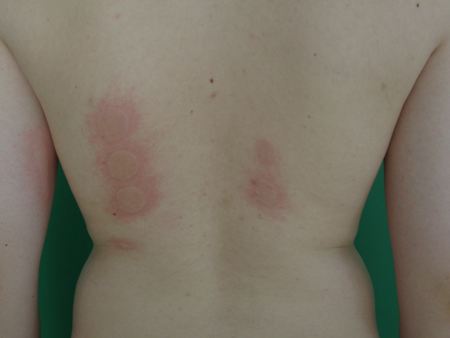
Unknown aetiology: pruritus is provisionally defined as pruritus of undetermined origin, although some of these patients may subsequently have a definitive underlying diagnosis.
Use of this content is subject to our disclaimer